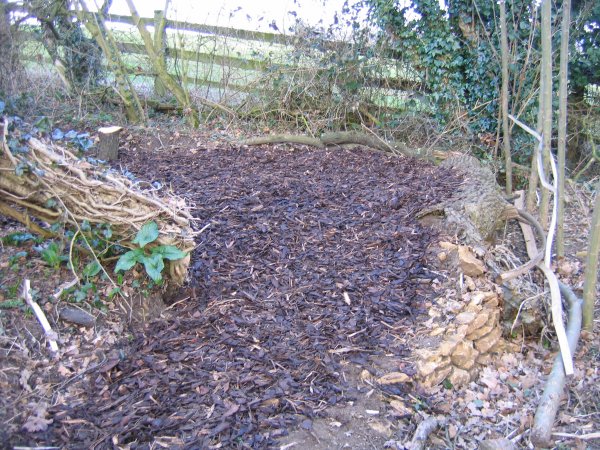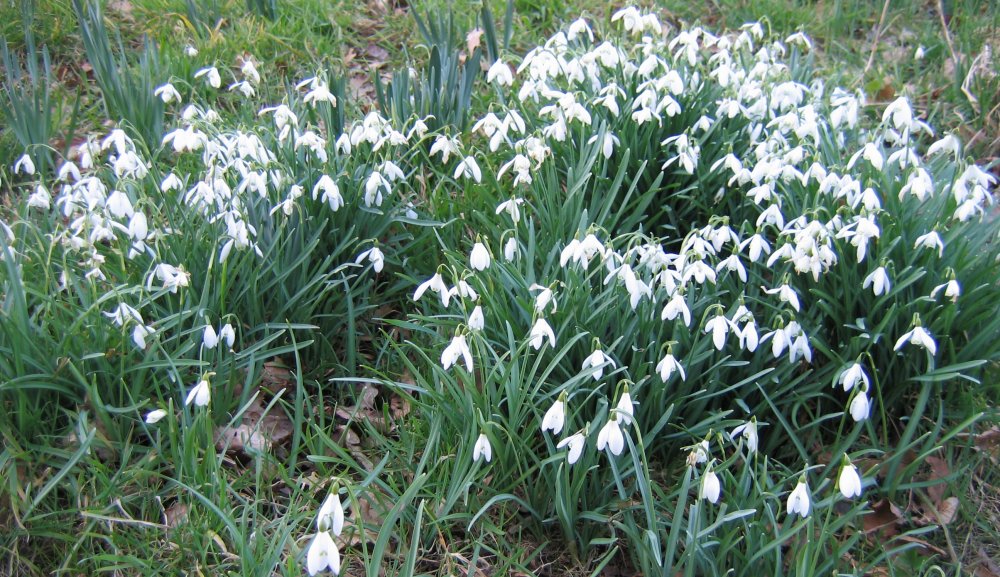
|
Diary - 03/06 |
|
March 2006 The cold weather continued. I was becoming worried there would be nothing to show anyone who came to look at the signs of Spring!
We braved icy winds to spread bark chippings on the meditation area to prevent weed growth during the year. On Sunday morning I removed all the dead foliage from the main herb garden and bewailed those plants lost to the weather and rabbits – the rosemary by the summerhouse was completely dead, both angelica plants had disappeared, the sage looked nibbled to extinction and holes around the Solomons seal plants told that some creature was aware of their edible roots! The white horehound, which had withstood all previous winters may well have perished, but we shall have to wait and see. On the
bright side, elder leaves were beginning to poke through their tiny shields,
the hazel tree was full of catkins and there were signs of female flowers on
the witchhazel. I also found new growth on valerian, heliotrope, yarrow and
hops plants in the top bed and goats rue, lemon balm, Echinacea pallida and
lemon balm in the main bed. Motherwort plants were everywhere and looked
very healthy as did the solitary woad. Nettles were springing up all around
the pond. Snowdrops were still dazzling with their beautiful white bells and
primroses and daffodils would soon be in flower.
25/6 March Maddie and Pauline joined me for the first workshop of the year. We began by gathering sticky buds from the horse chestnut trees on the roadside to make a flower remedy using the boiling method. The warmer weather certainly caused a growth spurt in the buds. The subsequent infusion was an opaque reddish brown which we combined with brandy in equal portions to take “for those who find it difficult to learn from life’s lessons and keep repeating the same mistakes”. I’d also not thought about sticky resin coating the inside of the saucepan, which made it a challenge to clean! It was fascinating to compare the differences in “wakefulness” between the different trees. We looked at horse chestnut, elder, ash, hazel, witchhazel, gingko biloba, crampbark, twisted hazel and hawthorn. The elder leaves were much more advanced than the previous week yet the ash looked totally dormant – not surprising since it is often the last tree to gain its leaves in May. We looked at the different plants growing – tasting the yarrow and dandelion, which had little flavour. It was interesting how much further forward the Echinacea pallida was compared with the augustifolia. Then we collected nettle tops in the afternoon for tea and to prepare a tonic wine for anaemia using nettles, apricots and orange skins as developed by Christopher Hedley. It was amazing how mild and refreshing the nettle tea tasted compared with older plants collected in other years. The workshop finished with the telling of “The Fairy Horseman” a tale connected with the horse chestnut tree. My father had been very busy in the time between our two visits, burning the rubbish under the two large ash trees and beyond the oak tree and clearing debris from against the next door neighbour’s fence. He also planted willow poles next to the mediation area in the hope they will grow and form a screen. On the Sunday morning I spent two hours digging and replanting. Primroses and snowdrops from my original garden at the bungalow were brought to line the entrance to the meditation area. The snowdrops originally came from my great uncle’s farm at Swell Hill in the early 1960s and the primroses from the banks of a disused quarry half a mile away where my sister and I played as children. This was before the Act of Parliament which made it illegal to dig up wild flowers! Motherwort and goats rue have proved themselves to be rabbit proof and very prolific over the past years, so I have taken the decision they no longer need to remain within protected space. I therefore dug a new border between the mulberry, quince and meddler trees and transplanted twelve motherwort plants, some of whom were accompanied by lemon balm and a young goats rue, so we shall see how they do there. During the Easter break I am hoping to remove all the motherwort and goats rue from the main herb bed, which should free up some room to grow plants I can use! The masterwort is also going to find a new home, since it put up several new plants last year but does not appear to have a modern medicinal use. There is still so much to be done, but it will have to wait until next month. |
||||||||||||||
|
Content Copyright © 2006 - Springfield Sanctuary. All rights reserved |
 18/19
March
18/19
March